“NL35 Series drives are not appropriate for true high duty-cycle enterprise workloads.” Hmmm! A niche market for drives or a stepping stone to the future? Please join me for a look at the Seagate ST3500641NS, 500 GB SATA 3Gb/s drive to ascertain if the differences this product brings to the table truly indicate this product’s future is as bright as the manufacturer’s literature suggests.
INTRODUCTION
With larger operating systems such as Windows Vista™ on the horizon and the size of software applications growing by linear proportions, hard drive manufacturers have responded in kind with larger, faster, and even cheaper storage options. I can remember watching a technical TV show in the not to distant past where the goal of the day was to build a workstation that contained 1 terabyte (1,000,000,000,000 bytes) of PATA disk storage. At the time, it required the use of a huge server style enclosure plus an additional external disk enclosure with a total of 9 or 10 disk drives to attain that lofty goal. We’re also talking speeds in the DMA4 range of 66 MB/s maximum I/O data transfer rates, which were rarely if ever attainable.
Wow, what a difference time and technology makes! With the advent of SATA drives and their respective controllers, the I/O data transfer rates are rated at 1.5 and even 3 Gb/s for the latest generation of drives. The speeds of these newer drives, even though very high, again are rarely attained due to other system bottlenecks. With the capacities of these drives currently in the 500GB+ range, it is very easy to have 1 terabyte of storage in smaller mid-tower and even desktop style multimedia cases. I guess size really does matter! I will even be so bold as to predict that we’ll see single drives in the 1+ terabyte range within the next six months.
For the longest time, when one thought of the professional workstation or server environment, we associated the then considerably faster, and equally more expensive SCSI drives with this type of venture. Such is no longer the case, as the migration to SATA derivations of these drives is rapidly taking place. The once “King of the Hill” SCSI drive has almost been matched speed wise by SATA. The biggest reason for changing to the new technology in addition to speed is the cost per gigabyte of storage. You can now easily purchase a SATA drive that is four to even six times larger in capacity for the same price as its SCSI counterparts. Up until the last month or two, the only check marks in the SCSI column were associated with longevity or mean time between failure (MTBF) and their ability to repeatedly access data for true high duty-cycle enterprise workloads.
Today, we’re going to review a drive that may play a role in in removing one of the remaining two check marks, longevity. Seagate recently introduced the new NL35™ series of SATA drives which they call “Near Line” that takes direct aim at the workstation/entry-level server environment. A quote from Seagate states: “The NL35™ Series drives are designed for workloads that fall between enterprise workloads and desktop computer or entry-level server workloads. NL35 Series drives are not appropriate for true high duty-cycle enterprise workloads.” Hmmm! A niche market for drives or a stepping stone to the future? Please join me for a look at the Seagate ST3500641NS, 500 GB SATA Drive to ascertain if the differences this product brings to the table truly indicate this product’s future is as bright as the manufacturer’s literature suggests.
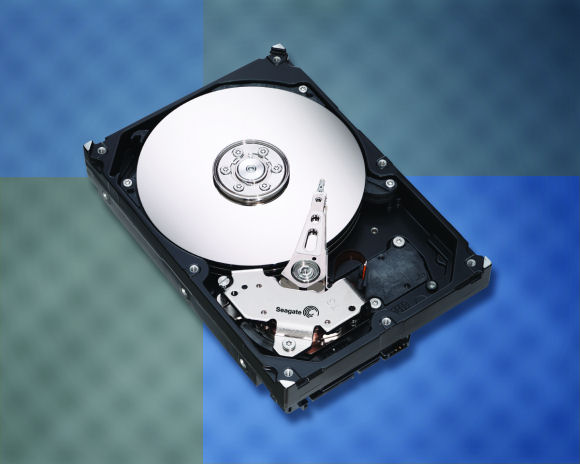
FUNCTIONALITY & SPECIFICATIONS
First, before we move into the heart of this review, let’s allow Seagate to answer a few questions that may be foremost on your mind about this new series of drives.
What’s the difference between SATA and nearline SATA?
Conventional SATA drives are optimized for desktop and low-cost server applications, which have less rigorous workloads and one or two drives per system. Nearline drives are designed to be more reliable when used in systems designed for nearline applications. Nearline applications are capacity-intensive, are powered on 24×7, but require infrequent reading and writing of data. Examples of nearline applications are disc-based backup/recovery, e-mail archiving, compliance archives, temporary data copies and medical image storage.
How does the NL35 Series performance compare with Barracuda SATA drives?
Under normal conditions, NL35 Series performance will be identical to a Barracuda SATA drive. In workload conditions beyond what the NL35 Series was designed for, the Workload Management feature for the NL35 Series may temporarily reduce read/write performance to enhance reliability in these situations.
When should I use NL35 Series instead of Barracuda drives?
For systems designed for capacity-intensive, multi-user applications that include many drives (four or more is a good rule of thumb). These applications are typically powered on 24×7, but have low disc drive read/write duty cycles. For these systems, the nearline features of NL35 Series are needed to operate and manage large numbers of drives, and to prevent high drive failure rates.
What new features will be available on the NL35 Series 500-Gbyte drive?
NL35 Series 500 will use a SATA 3Gb/s interface, as well as improved RV tolerance and enhancements to the nearline firmware feature set. (Current NL35 Series SATA is a 3-disc design; NL35 Series 500 is a 4-disc design).
FUNCTIONALITY & SPECIFICATIONS cont.
Specifications
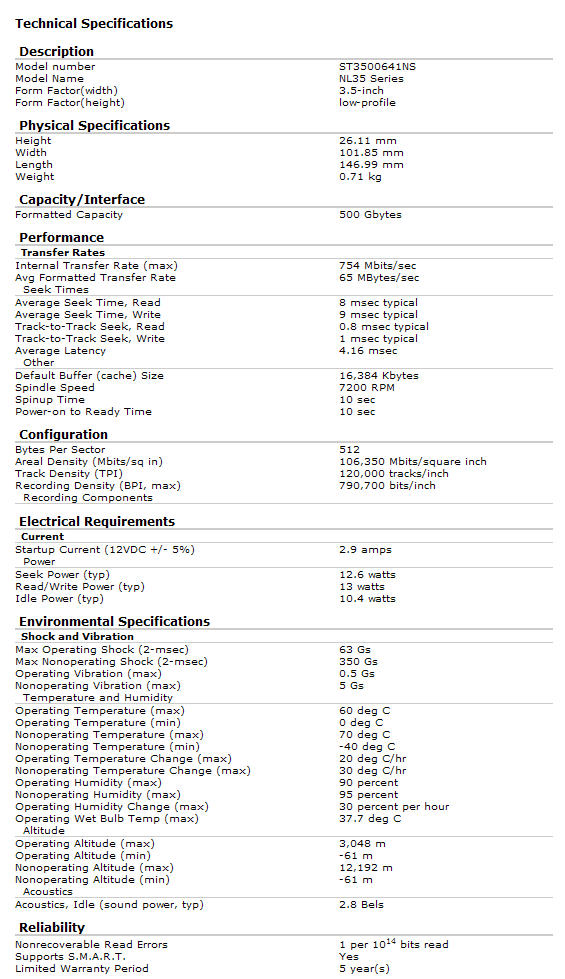
Features

First Impression
When I unpacked this drive from its sturdy shipping container, my first impression was that it is considerably heavier than either my 80 GB or 120 GB Barracuda 7200.7 drives. I would assume the added weight to be primarily due to the capacity of the drive and the fourth platter that is added.

The top surface of the drive appears more polished and possibly a little thicker than either of the two drives I own. Shown in the picture below are the Barracuda 120 GB 7200.7 drive on the left and the ST3500641NS, 500 GB drive on the right.

Turning the two drives over to view the circuitry on the underside showed the ST3500641NS to have much cleaner lines with apparently better solder joints and much more staunch looking traces. The PCB is possibly even a bit thicker, but I can’t really tell for sure, and there’s no simple way to measure it. You decide for yourself in the photo below which drive is which.
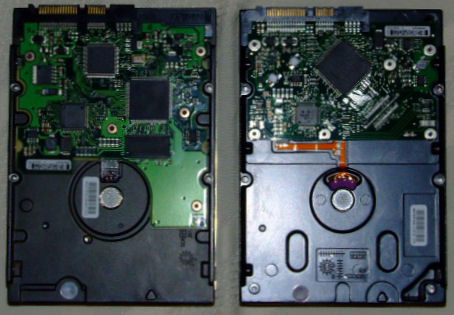
Here’s a close up of the circuitry on the Seagate ST3500641NS.

TESTING
Test System
- Motherboard: Intel D875PBZLK
- Processor: Intel 3.4 GHz Northwood run at default speed
- HSF: ZALMAN CNPS7000B-CU
- Video Card: ATI X800XL run at default speed
- Optical Drives: Plextor PX-750A
- Hard Drives: Seagate Barracuda 7200.7 80 GB SATA drive; Seagate NL35.2™ ST3500641NS 500GB drive
- Memory: 2GB Patriot PC 3500 DDR SDRAM (review)
- Sound Card: Turtle Beach Santa Cruz
- Case: Rear: Antec P150 (review)
Benchmarking Tools:
- SiSoft Sandra 2007
- ATTO’s HD Benchmarking Tool
- Simpli Software’s HD Tach
Test Methodology
I decided to do a side-by-side comparison of the Seagate ST3500641NS 500GB drive to my current Seagate Barracuda 80GB 7200.7. My thoughts were that the smaller drive would probably come closer to competing with the larger drive due to having a smaller area to retrieve data from and might even have a better “Random Access Time.” Note that I found a copy of SiSoft’s newest version of Sandra (2007) to use with these benchmarks.
Sandra 2007 Benchmarks
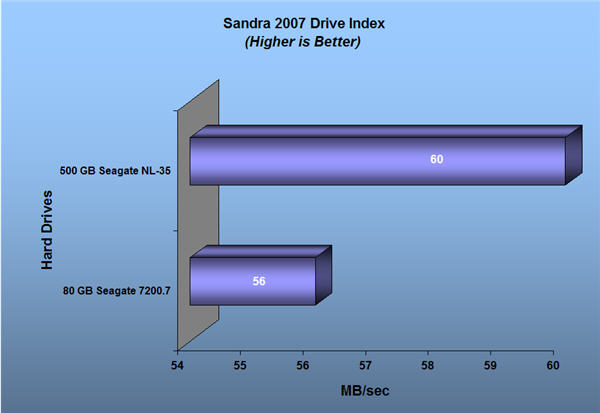
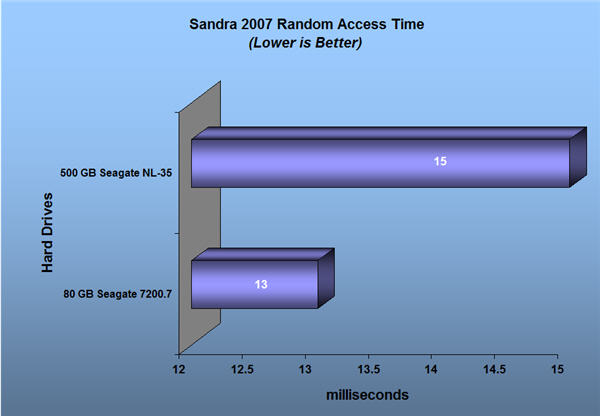
HD Tach Quick Benchmark (8MB Zones)
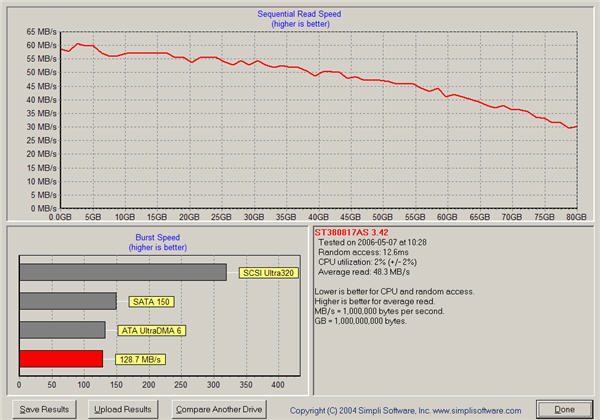
Seagate 80GB 7200.7
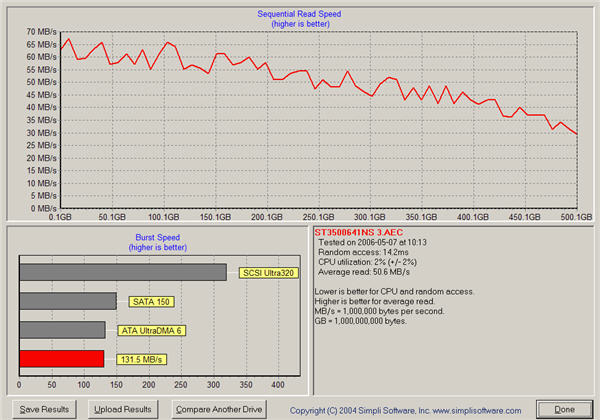
Seagate 500GB NL35.2™
TESTING cont.
HD Tach Long Benchmark (32MB Zones)
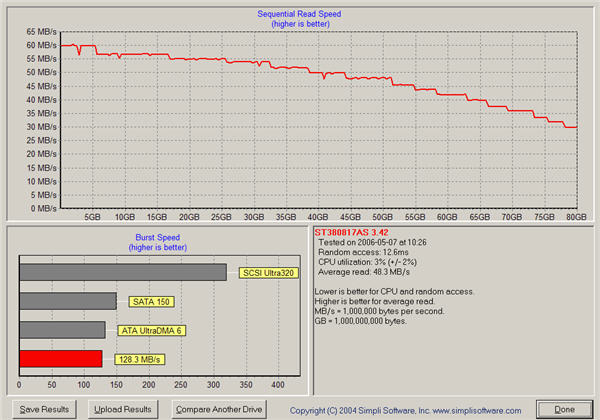
Seagate 80GB 7200.7
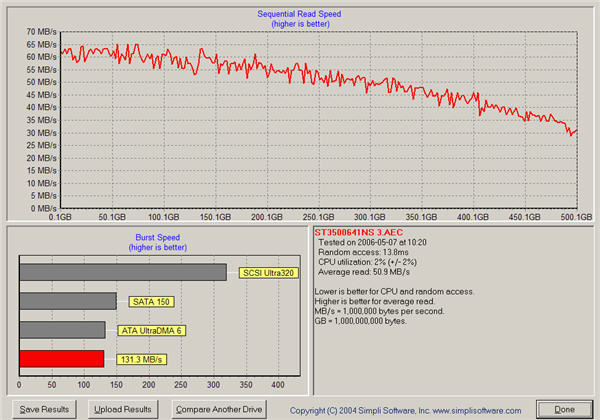
Seagate 500GB NL35.2™
Atto HD Benchmark
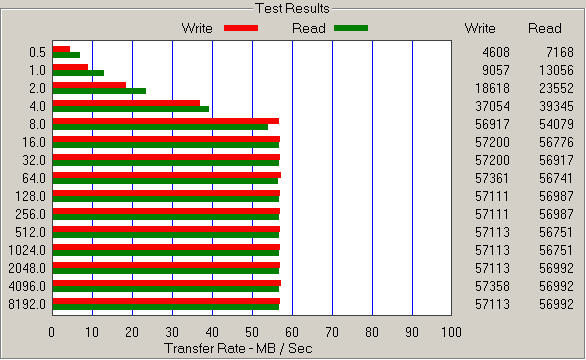
Seagate 80GB 7200.7
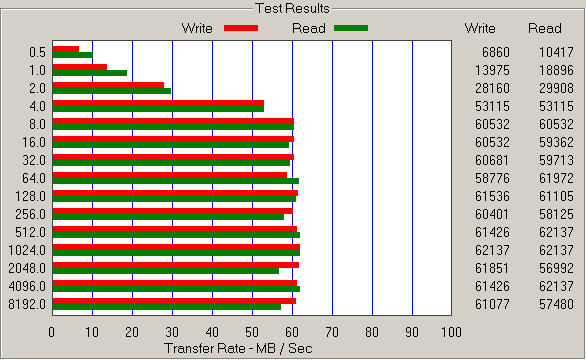
Seagate 500GB NL35.2™
Impression
The included benchmarks indicate that in all areas with the exception of Random Access Time, the Seagate ST3500641NS 500GB drive is a clear winner, even though the differences between the two are not what one might consider staggering. As I alluded to earlier in my pre-test hypothesis, the Barracuda does take a marginal win in the Random Access Time category. I think this is primarily due to: 1) It is a smaller drive with less platter area to search; and 2) The NL35.2™ Series is designed with a Workload Management feature that may have lengthened the Random Access Time ever so slightly. Both of these reasons are merely supposition on my part. Suffice it to say, the newer technology wins the speed race.
CONCLUSION
I’ll have to say I’m very impressed with the Seagate® ST3500641NS 500GB drive. It’s a real performer and in fact not a niche market at all but probably more realistically Seagate’s conduit to their next generation of SATA drives that will help further to reduce the SCSI dominance in both the workstation and server environments.
While this drive retails for somewhere in the $300 to $350 USD range, it’s probably not the drive for every Computer Enthusiast’s desktop. If I were judging this product strictly on Computer Enthusiast needs, I would probably detract considerably from this product’s final score for the price being very high as compared to other SATA drives. In fact, this product has to be looked at more from the point of view of a company wanting it for a $10,000 workstation or server in lieu of or in conjunction with its SCSI counterpart. Oh wait! It does not have a SCSI counterpart when it comes to size, only to cost. A 300GB SCSI drive, which is amongst the largest currently made, would cost the same company almost $500 USD. So, the cost per gigabyte ratio for this drive then becomes much more attractive.
I can highly recommend this drive to any individual or company in the market for either a workstation or server drive that meets the following criteria established by Seagate: “For systems designed for capacity-intensive, multi-user applications that include many drives (four or more is a good rule of thumb). These applications are typically powered on 24×7, but have low disc drive read/write duty cycles.” I also believe this drive to be quite suitable for entry-level server use disregarding the above stated criteria. It’s probably also an excellent choice for the Computer Enthusiast wanting one or more drives to backup their valuable data as the MTBF would suggest it has a surprising longevity. Let us also not forget that like every other Seagate drive, these drives possess an amazing five-year warranty.
This review was both meant to give a fair assessment of the Seagate ST3500641NS 500GB drive and to wet your whistle for things yet to emerge. That’s right, this is merely the beginning for this drive as it, along with two of its twin brothers, will be the featured storage system for a rather massive second part to the RAID: A Guide For All … Part 1 that I wrote back in March. I expect to publish the second part of this guide in early June and plan to include mini reviews and extensive benchmarks for RAID controller cards, these drives, and some adjunct software from the major manufacturers utilizing RAID 0, 1, and 5 that are suitable for the Computer Enthusiast’s system. This will be a very meaty article and will be all about performance in the RAID arena.
I would sincerely like to thank the wonderful people at Seagate for supplying not only this drive, but two identical to it for the upcoming Part 2 of RAID: A Guide For All.
Pros:
+ 500GB of storage
+ Very low CPU utilization in benchmark
+ 16MB cache
+ Considerably better cost/GB ratio than SCSI
+ 5 year warranty
+ 300 MB/sec I/O threshold
Cons:
– Price for general use may be prohibitive
Final Score: 8.5 out of 10 and the Bjorn3D Seal of Approval
 Bjorn3D.com Bjorn3d.com – Satisfying Your Daily Tech Cravings Since 1996
Bjorn3D.com Bjorn3d.com – Satisfying Your Daily Tech Cravings Since 1996



